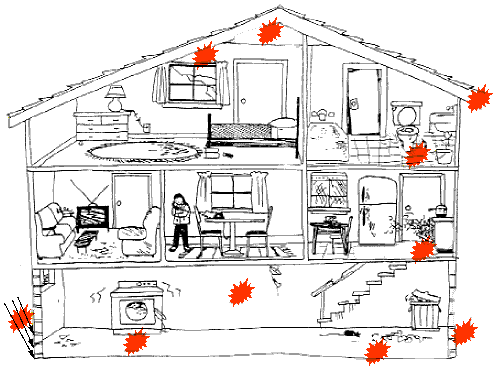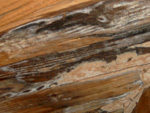
How do I know I have mold in my house?
Airborne Contaminant Samplings
Air-O-Cell spore trap samples - The Air-O-Cell cassette operates upon the principle of inertial impaction. Particulate laden air is accelerated as it is drawn through the cassette’s tapered inlet slit and directed towards a small slide containing the collection media, where the particles become impacted and the air flow continues out the exit orifice. The adhesive nature of the collection media prevents the collected particulate from blurring or being washed off during the staining process and eliminates sample loss from vibration during sampling and handling.
Culturable bioaerosol samples involve the collection of viable biological agents, such as fungi or mold, on sample media (i.e., agar) that Can be grown in laboratory culture. Culturable sampling is one of the moat common methods of volumetric air sampling for bioaerosols. Culturable sampling allows for the differentiation or ''speciation" of different microorganisms when required. It also provides counts indicative of how many spores are viable (i.e., capable of growing) and present in the air.
However, culturable sampling methods require that the spores in the air are alive, survive the sampling process, germinate on the sampling media, and compete welt with other species present on the growth media. Culturable sampling does not indicate the presence of non-viable spores, which may also be capable of producing allergies or irritation. in addition, some viable spores may not be present at all times of the day or in high concentrations, Therefore, certain viable spores may be missed at certain times of the day. Because this sampling involves short-term grab sampling, it may not be indicative of long-term average air concentrations.
Services

Surface Contaminant Testing
The primary purpose of surface sampling is to utilize direct microscopic examination of a surface to determine whether or not mold is growing on the surface sampled, and if so, what kinds of molds are present. Secondarily, mostsurfaces collect a mix of spores which are normally present in the environment. At times it is possible to note a skewing of the normal distribution of spore types, and also to note "marker" genera, which may indicate indoor mold growth. Surface sampling may therefore reveal indoor reservoirs of spores which have not yet become airborne, However, the presence of biological materials on a particular surface is not a direct indication of what may be in the air. Health problems related to indoor microbial growth are generally caused by the inhalation of substantial numbers of airborne spores, sometimes over a substantial period of time.
Direct/Lift Samples - This type of sample is similar to Air-O-Cell spore trap sampling in that is speaks about any spores found whether living or dead. Occasionally, spores found is samples of his type may have fruiting structures and/or hyphae associated with a particular spore. this is an indication of possible ongoing growth. If an area contains suspected growth, this is often the fastest and most effective means of determining the type of growth in the area.
Swab/Culturable Samples - As the name implies, samples of this type are cultured to determine the presence of any viable mold species. Disadvantages to this type of samplings are similar to those described above in the culturable bioaerosol samples.

Roof and/or windows leak
Poorly vented attic.
Clogged and/or broken gutters or downspouts.
Bathroom: Plumbing problems and/or inadequate ventilation (no window or exhaust fan.)
Kitchen: Plumbing problems and/or inadequate ventilation.
Poorly maintained HVAC and ductwork.
Water intrusions through the basement walls and floor.
Damp basement.
Moisture from leaking washer and/or improperly vented dryer which allows lint to escape into the room.
Poor grading can direct water into foundation.
AMT Mold Testing and Consulting
(215) 441-5171 (866) 441-MOLD (6653)


